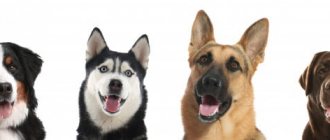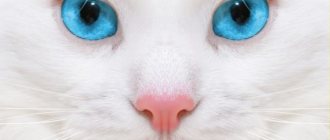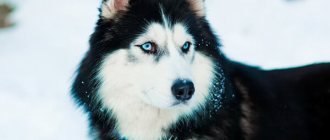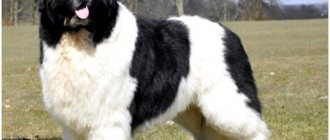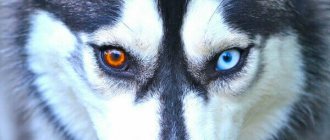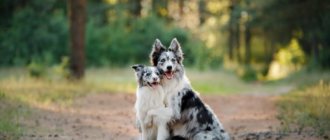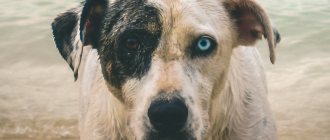Although blue is the coldest of colors, it is so exciting and beautiful. There is probably no person who would indifferently walk past a dog staring at him with blue eyes. Is it because of the charm? Perhaps a dog's blue eyes, which look like someone put glass marbles in their sockets, can be hypnotizing. Dogs with blue eyes attract us like magnets.
Blue eyes, which make a dog stand out from its peers with other eye colors, are the result of a recessive gene. The dominant eye color in dogs is brown. Many people believe that only Huskies can have blue eyes. This is partly true; in most breeds, blue eyes are considered a defect.
Most often, they are responsible for the merle gene, which gives dogs a spotted or merle color and reduces the amount of dark pigment in the eyes. Therefore, blue eyes are considered the norm in those breeds where merle coloring is acceptable in dogs. Most often, such features are found in the border collie, corgi, and Australian shepherd breeds. But this does not mean that blue eyes are a breed-specific trait. The color of the iris is mainly influenced by genetic conditions. And although the blue eyes are cold as ice, the hearts of these four-legged creatures beat the strongest.
1. Welsh Corgi
Once upon a time, this little dachshund-like paw was used to herd livestock. Today it is usually a family dog that guards the house well despite its small size. She is very attached to her family, especially her owner. She always treats children with caution and is distrustful of strangers. The dog is energetic, so you need to play and walk with it a lot.
The Corgi learns quickly and willingly, but he can also quickly develop bad habits. Alert, timid, barking loudly - he is an excellent protector. This is a very hardy companion for long rides and can even practice canicross. Corgi hates inactivity because he gets bored easily. The breed is also characterized by rapid weight gain. Marbles with the merle gene can have different eye colors: blue, spotted or brown.
Size: small dog, 30 cm in length Life expectancy: 15-17 years Price of a corgi with a pedigree: 60-80 thousand rubles. Country of Origin: UK
2. Siberian Husky
Representatives of this dog breed are stars of both sleigh and tricycle racing. They delight with their unique beauty and magical blue eyes. Their friendly, joyful disposition and good relationship with children contributed to the great popularity of this breed. Huskies are great as pets, but it is worth knowing that their intelligence, curiosity about the world and sporting spirit can make them unmanageable if not properly trained and cared for.
photo source
In the city, a dog of this breed must be kept on a leash. They require not only regular walking, but also additional activities such as jogging or bikejoring (a separate sport discipline in which a dog pulls an athlete riding a bicycle). It is also advisable for huskies to participate in dog sports. The Husky is alert, but too gentle to act as a protector. Intelligent, but independent and freedom-loving, he is not easily subjugated.
source
Size: medium dog, 51-60 cm Life expectancy: 13-15 years Price of a husky with a pedigree: 40-60 thousand rubles. Country of Origin: USA
3. Australian Shepherd
The Aussie is an intelligent and versatile dog that needs a lot of activity. The instinct of a shepherd and protector is encoded in the genes, which explains his tendency to bark a lot. It has a reputation as the most shedding breed, but it does not require frequent bathing - the dog's coat is self-cleaning. Rather friendly and trusting, communication with people is most important to him - he often follows them like a shadow. He loves to play with children and willingly makes friends with another dog or even a cat.
The dog attracts attention with its original beauty, especially its marbled coat. The eyes of these shepherds can be blue, with heterochromia: for example, one is blue and the other is brown, or half blue, spotted, brown. Because of the color of their eyes, the Indians called this breed ghost dogs.
Size: medium, 46-58 cm in length Life expectancy: 14 years Price of an Australian shepherd with pedigree: 50-70 thousand rubles Country of origin: USA
4. Border Collie
You won't get bored with this breed. Gifted with exceptional temperament, intelligence and a desire to work, the Collie will constantly look forward to tasks. Collie quickly understands what is required of him. It is not for nothing that this dog ranks first in the list of the most intelligent breeds, according to Stanley Coren's rating. If the dog is not occupied, left alone at home, he can find many things to do, sometimes wreaking havoc.
The Border Collie is very sociable, caring and patient with children. Distrustful of strangers, making it a good protector. The Border Collie is good at sports such as flyball and Frisbee. Because of the ease with which he learns, he often appears in commercials and films. Breeds of marbled dogs delight not only with their appearance, but also with their blue eyes. In this breed there are not only dogs with blue eyes, but also the eyes can be of different colors (one eye is blue and the other is brown).
Size: average dog - 53 cm in length Life expectancy: 13-15 years Price of a border collie with pedigree: 80-100 thousand rubles. Country of Origin: UK
5. Catahoula Leopard Dog
The Leopard Catahoula is made to work. She is brave, confident, full of energy, but balanced. She has a strong herding and hunting instinct. Distrustful of strangers, can become fiercely defensive if necessary. The Leopard Dog learns quickly and has an excellent memory, but can be stubborn. She enjoys being the center of attention and completing tasks. If this dog is not dealt with, it can become unbearable and destroy everything that comes to mind.
A properly raised dog is devoted to family members and caring towards children. Suitable for an experienced and consistent person. Catahoulas often have beautiful blue eyes that can hypnotize. US President Theodore Roosevelt was a fan of this breed.
Size: large dog, 51-66 cm Color: black, chocolate, blue marble, chocolate marble, brindle. Life expectancy: 12-13 years. Price per breed: 70-100 thousand rubles. Country of Origin: USA
Interesting for you:
Sheltie
Marbled Sheltie
The predecessors of the Sheltie were bred for herding work in the Shetland Islands near Scotland. Outwardly, they resemble smaller long-haired collies, but are recognized as an independent breed. Blue eye color is allowed for Shelties with the merle gene, which is responsible for the merle color.
Purebred dogs
There are 14 different types of purebred dogs that can genetically have blue eyes. They can carry them by having a dominant gene for blue eyes. Some breeds get a theme from the Merle pattern, which can cause discoloration in both the coat and eyes. Some dogs get exclusively blue eyes due to heterochromia, a melanin imbalance. In our list below we do not include dog breeds that have albinism, as it is extremely rare.
Siberian Husky
The Siberian Husky is the most popular breed with blue eyes.
The Siberian Husky is perhaps one of the most famous blue-eyed breeds. It is hypothesized that canine chromosome 18 ALX4 is associated with the beautiful blue eyes for which Siberian Huskies are famous. These puppies are a working breed, so if you are looking to get one of these, make sure you have enough space. These puppies need regular exercise or they may develop destructive tendencies.
Australian Shepherd
Aussies are another breed that may have blue eyes.
Aussies are another popular breed that regularly carry the blue-eyed gene. The Aussie is often confused with another puppy on this list, the Border Collie. The Aussie is a very energetic working breed that comes in a variety of coat colors. While apartment living may suit these pups, it is preferable to have a large yard where they can roam. These puppies may also suffer from separation anxiety. If you are planning to get a Shepherd, it is best if you are at home with your puppy regularly.
Weimaraner
Although Weimaraners typically have yellowish eyes, they can also carry the blue gene.
Weimers are another breed that can carry beautiful baby blues. A friendly but fearless companion, this breed has a beautiful silver or almost copper coat. Many believe that the Weimaraner was bred in the Labrador line, which is why silver Labradors exist today. These puppies do best in a large yard as they have a lot of energy. They are easy-going and generally excellent family dogs.
Dalmatian
Dalmatians can have blue eyes, but this is often associated with deafness.
Dalmatians with beautiful spots may have blue eyes. This is quite rare and, unfortunately, many blue-eyed Dalmatians are deaf. Veterinarians and scientists do not know the exact cause of hearing loss, but the two diseases are genetically related and are quite common. There are also several varieties of Dalmatian crosses that can carry the blue-eyed gene.
Border Collie
Border collies can have blue eyes when they are blue merle puppies.
Are you ready for such ENERGY? Border Collies are one of the most energetic breeds that carry the blue-eyed gene. They are equally cute and very beautiful thanks to their long, flowing coat. They require regular grooming as they shed more frequently than other breeds. This puppy will do well in a large fenced yard as they enjoy protecting their pack in open spaces. Border collies are some of the smartest dogs in the world and they learn basic obedience very quickly.
Dachshund
Dachshunds may also carry the blue eye gene
Dachshunds are another adorable breed that can, in rare cases, have blue eyes. This is typical for Merle dachshunds, which means their coat is almost marbled in color. These eccentric puppies are calmer, but at the same time very attached to humans. It is known that they can become aggressive if they are not trained and socialized at an early age.
Corgi
Corgi dogs can also have blue eyes depending on their coat color.
Like the Dachshund, the Corgi can have light blue eyes and a merle-colored coat. The Welsh Corgi, or Pembroke Corgi, is a smaller dog with an attached tail. They are known for their adorable asses and very sweet personalities. Corgis can be quite expensive, but if you want a puppy, you'll likely be waiting in line at a breeder.
Sheltie
Like the Aussie, the Sheltie is another shepherd with blue eyes.
The Shetland Sheepdog, also known as the Sheltie, is another potential blue-eyed herding dog. Like the Dachshund and Corgi, this is another breed that is most likely to have blue eyes with a merle coat. Blue merles carry this gene, as do bi-blue merles. If blue eyes are caused by something else, it is considered a fault for show purposes. Shelties are similar to Border Collies in appearance and need a lot of space to run. These are very energetic breeds that do well when at home with their family.
Malamute
The Malamute is similar to a husky and has a similar eye color.
The Alaskan Malamute is a large dog that sometimes has blue eyes. They are often confused with the large Siberian Huskies. The Malamute is a working breed known for its fluffy white and black coat and blue eyes. Like the Husky, this puppy was bred as a service dog for sled riding, pulling and carrying. It is best to have a large fenced yard for this puppy since they are active. It is also recommended that this breed be kept in cooler climates as they have a long and fluffy coat. It is recommended that this breed be kept in cooler climates with their long and fluffy coat.
German dog
Although rare, Great Danes can have blue eyes.
The Great Dane is one of the few giant breeds that have the blue-eyed trait. Blue eyes are more common in this breed when they have a merle coat or when they are black and white and suffer from heterochromia (two different colored eyes). This breed is very tall and very lazy! They will need plenty of space in your home to do what they do best as bums. They are incredibly sweet and good-natured family dogs.
Catahoula
The Catahoula Leopard Dog is another breed that typically has blue eyes.
This herding dog is known for working on ranches and helping to protect the land from predators. You will need a plot of land for this puppy to roam, and they are not suitable for apartment living unless you maintain a strict exercise schedule. These pups need to spend at least 60 minutes outdoors every day to keep their minds occupied. The Catahoula is an excellent family dog and does well in multi-pet households.
Cane Corso
Some Cane Corsos have a faint light blue tint to their eyes.
The Cane Corso, known as the Italian Mastiff, is another puppy with blue eyes and the same bluish-gray coat. Like the Pit Bull Terrier, blue eyes are uncommon in Cane Corsos unless they have a silver coat color. Cane Corsos have a calm character and can live well in an apartment. Like other mastiff breeds, this puppy is a big couch potato and usually only needs 30 minutes of exercise a day.
Shepherd panda
Panda shepherd dogs were bred relatively recently in the United States. The list of breeds that participated in the selection is not disclosed. The bright color of the animals combines 2 or 3 contrasting colors. Must include large white spots that cover at least one eye. Panda Shepherd Dogs are not recognized by the FCI, but are popular and registered in the USA. Blue-eyed dogs participate in exhibitions along with dark-eyed ones.
Crossbreeds
Now that we've covered purebred breeds, we can't leave out the fantastic mixed breed puppies that can also have blue eyes. The Siberian Husky is one of the few breeds with naturally blue eyes, so you'll see a few different Husky mixes on this list. There are also several Australian Husky crosses. Let's take a look at the best mixed breed puppies that can have blue eyes!
Pomsky
Pomskies can inherit blue eyes from their husky parents.
The Pomeranian Husky mix is a miniature version of the Husky and is quite expensive! This miniature fluffy husky is an attempt to get the soft and fluffy coat of an orange, complemented by the beautiful blue eyes of a Siberian husky. Pomskies are very popular designer dogs. They are highly sought after and often cost $3,000 or more in the US!
Saint Berchu
Thanks to heterochromia, inherited from their Husky parents, St. Bernards can have blue eyes.
The Saint Berhusky is a cross between the Siberian Husky and the Saint Bernard. This unique breed inherited blue eyes from its Husky parents. It is possible that they will end up with heterochromia, where they have one eye of each color. This cross will be a little calmer than the Siberian Husky, but with a slightly thicker, longer coat. These are large dogs whose weight can reach 100 kilograms.
Husky Inu
Most Huskies have brown eyes, but they can also be blue.
The Shiba Inu Husky mix is a mix of the Siberian Husky and the Shiba Inu. This crossbreed is similar to a Pomsky in that they are designer dogs that are in high demand. They come with a high price tag, with puppies often priced at $1,500 or more. This mix will be slightly smaller than the husky parent, and they often have a pair of stunning blue eyes.
Goberian
Gobers may have the blue eye gene inherited from their Husky parents.
The Gober breed is a mix of Golden Retriever and Siberian Husky. This unique mix can look completely different between two puppies from the same litter! However, it is a very popular crossbreed and is often used to produce a dog that looks like a Golden Retriever but with blue eyes. It is a medium to large sized cross and will do best in a large yard. Gobers have a lot of energy and are more socially adaptable to new environments than purebred Huskies.
Gerberian Shepsky
Like their Husky parent, Shepskies can have blue eyes.
The Husky German Shepherd mix is another breed that is commonly found with blue eyes. German Shepherds are reported to occasionally have pure blue eyes, but this is considered a breeding defect and is extremely rare. When crossed with a Husky, the chances of this breed having blue eyes are 50/50. This breed is extremely popular and comes in a medium to large size. They will do best in a house with a yard. They can live in an apartment, but they need regular exercise.
Haskador
Huskadors may have blue eyes, also inherited from the Husky.
The Huskador is another blue-eyed dog breed that is a cross between a Husky and a Labrador. This puppy will look more like its Labrador parent and will most likely carry the gene for blue eyes. Since the Labrador is one of the most popular breeds in the world, it makes sense to cross one with a Husky to see if they can get those beautiful blue eyes.
Horgi
Husky Corgi mixes may have blue eyes from Husky parents.
The Horgi is another beautiful crossbreed with blue eyes. This mix is a cross between a Husky and a Corgi. Since both parents have the gene for blue eyes, this crossbreed has a greater chance of producing puppies with blue eyes. The Horgi is a very cute puppy that is slightly larger than a full-sized Corgi. Another popular designer dog, this breed is medium in size and, due to its energy, is best suited for a home with a small yard.
Siberian Aussie
If both parents have blue eyes, then there is a high chance that the Siberian Aussie will have them too.
Another mixture of two potentially blue-eyed dog breeds is the Siberian Aussie. This designer dog is a mix of Australian Shepherd and Siberian Husky. These puppies are very energetic and are likely to have blue eyes. Their coats come in a variety of colors, from white and black to brown and merle. This cross will be slightly larger than an Australian Shepherd and slightly smaller than a Siberian Husky. They will need free space to roam as their energy levels are very high. Australian Siberian Huskies can become destructive without proper energy output.
Aussiepoo
Although rare, Aussiepoos can have blue eyes.
The Aussiepoo is a cross between an Australian Shepherd and a Poodle. The likelihood of this crossbred carrying the gene for blue eyes is lower since the Poodle is not known to have blue eyes at all. If an Australian Poodle receives the merle gene from its Australian Shepherd parents, then there is a chance that it will have blue eyes. This fluffy puppy will have a lot of energy. Their Poodle parent is extremely active. This breed can challenge even the most patient dog owner. It is recommended to have a large yard for backyard play or to exercise your Australian Poodle for at least 60 minutes daily.
Border Aussie
Blue eyes are common in Border Aussies because both parents carry the gene.
The Border Aussie crosses two potentially blue-eyed dog breeds by mixing a Border Collie and an Australian Shepherd. The Border Aussie is a bundle of energy and does best with plenty of exercise. Both parent breeds are likely to be merle, which means this cross may well have a pair of blue eyes to match its long, silky coat. Border Aussies can do well in an apartment as long as they get plenty of exercise. They love being around family and are affectionate dogs when they are not entertaining themselves. Border Aussies make excellent dogs for agility training and are very intelligent.
Aussidor
An Aussie can inherit blue eyes from its Aussie parents.
The Aussiedor is a cross between a Labrador Retriever and an Australian Shepherd. Only the Australian Shepherd parent carries the gene for blue eyes, but this still means that Australopithecus could have blue eyes. To achieve blue eyes, this pair will require merle wool. The Aussie is a loving and affectionate breed. Smaller than a purebred English or American Labrador, this mix lacks the enthusiasm of either parent. They will do well in a small yard if given regular exercise.
Australian Shepherd or Aussie
Aussie merle color.
Contrary to its name, the breed was bred in North America on the basis of shepherd dogs imported from Australia. Among Aussies, it is difficult to find two identical dogs. Each one develops a unique combination of shades and coat patterns. Marbled Aussies are often born with blue irises. This feature is specified in the standard.
Possible diseases
There are breeds that are predisposed to various heart defects, which cause blue tongue and other dangerous symptoms:
- severe shortness of breath;
- cardiac cough;
- breathing with wheezing, gurgling and whistling;
- greedy swallowing of air even after minimal physical exertion;
- neck stretching;
- restless behavior.
All this can be an alarm bell for the development of ventricular septal defects or tetralogy of Fallot.
Note!
These pathologies are diagnosed in most cases in puppies in the first six months of life. English bulldogs, Shih Tzu boxers, etc. have a predisposition to them.
Unfortunately, there are no effective treatments for heart defects. You can only choose the right supportive therapy to support the heart and eliminate the possibility of fluid getting into the lungs. Pneumothorax is considered no less dangerous for dogs, which can be caused by the following reasons:
- chest wound;
- broken ribs;
- cuts in the abdomen;
- teeth marks from bites from other animals.
With pneumothorax, the pet becomes lethargic, refuses to eat, and shortness of breath and coughing are heard at the slightest exertion. When examining the oral cavity, you can see bluish gums and tongue.
Since there is a high risk of suffocation, you should not delay a visit to the veterinarian for even a minute. An X-ray and ultrasound of the chest may be needed to understand the cause of pneumothorax. Next, air is pumped out of the lungs using drains in the pleural cavity and oxygen support is provided. In cases of serious injury or injury, sedatives or anti-shock therapy may be prescribed.
Many dog owners are terrified by the diagnosis of heart failure in their pet. It most often develops with age, but many congenital cases are known in brachycephalic breeds. Heart failure can be diagnosed based on the following signs:
- sudden cough;
- lethargy;
- refusal to eat;
- shortness of breath at rest;
- blue color of the tongue, palate and gums.
Adult dogs are also susceptible to pulmonary edema, which can be caused by chronic bronchitis or heart problems. It develops rapidly, making the animal restless. There is a gurgling cough, grunting and severe shortness of breath. In severe cases, the tongue and the inside of the cheeks turn blue. In this case, it is better not to hesitate, as there is a risk of losing the dog. The solution to the problem is to find and exclude the causes that led to pulmonary edema and take diuretics.
Important!
Acute forms may be accompanied by fainting and foaming at the mouth.
More rarely, the tongue may turn blue due to collapse of the trachea, to which breeds such as the Yorkshire Terrier and Shih Tzu are predisposed. It can be congenital (inherited) or acquired (as a complication after suffering respiratory pathologies). At the initial stage, you may notice that the pet clears its throat after palpating the trachea area or slightly pulling the collar. Subsequently, shortness of breath and blue tongue appear. For diagnosis, endoscopy can be performed, thanks to which it will be possible to see the trachea from the inside. Treatment is medicinal and surgical, depending on the age of the animal and the severity of symptoms.
Husky
These are the most popular blue-eyed dogs with a rich palette of iris shades: from pale azure to rich blue. More often, the blue iris is combined with black, gray shades of fur, less common in pure white, red, and chocolate huskies. Heterochromia is allowed when one eye is brown and the other is blue.
Bull Terrier
You'll easily recognize a Bull Terrier when you see one! It is a distinguished and unusual-looking dog with an ovoid head , a wide and rounded muzzle, pointed ears and a medium-sized muscular body. Its triangular eyes are often dark brown, but on very rare occasions you may see this white dog with blue eyes. This is more common when crossing a Bull Terrier with a Merle dog.
Fun fact: Bull Terriers were first bred in the 1830s as fighting dogs, likely by crossing the Bulldog with the now extinct White English Terriers and Dalmatians to increase their size. Bull Terriers were considered gladiators in the dog fighting ring and were valued for their strength and tenacity.
Border Collie
Breed selection began in the border areas of England and Scotland in the 19th century. Now Border Collies have spread throughout the world and are renowned as the most trainable dogs. A blue iris is typical for the blue merle border collie (blue merle), less often combined with two-tone colors.
Prerequisites for the appearance
A dog's purple tongue should alert its owner. This can become a prerequisite for several diseases at once, including those directly related to the life of the pet. The normal color of the mucous membranes of a dog's mouth, its lips, gums, tongue, and the inner surface of the mouth is pink.
Important! The mucous membranes acquire a lilac hue when there is a lack of oxygen in the blood. If a dog's tongue turns black, this is a sign of poisoning
It happens:
If a dog's tongue turns black, this is a sign of poisoning. It happens:
- food, when an animal eats toxic products or poisonous substances mixed into food;
- respiratory, when toxins of toxic substances enter the body through the respiratory system;
- contact, absorption of poisons into the blood through the skin.
In case of poisoning, vomiting and diarrhea are observed, the dog loses its appetite, the muscles stop obeying, and convulsions appear.
Collie long-haired and short-haired
These are 2 related but distinct herding breeds from Scotland. Friendly dogs have earned a reputation as intelligent companions and sensitive nannies for children. Blue irises are only allowed for Blue Merle Collies. In animals with sable, tri-colored coat it occurs occasionally, but is considered a fault.
Welsh Corgi Cardigan
The Cardigan Welsh Corgi has a similar build to the Dachshund, with a long body and short legs, although this herding breed is slightly larger, ranging from 11.5 to 17.5 kg. Their coats come in a variety of colors, including red and blue merle, and their tail is long and bushy. According to the official Cardigan Welsh Corgi standard, "blue eyes in any coat color other than blue merle are disqualifying."
The cardigan’s wide “smile” is an outward manifestation of his friendly disposition . Affectionate and good-natured, the Cardigan Welsh Corgi gets along well with children, older people, other dogs and even cats.
Fun fact: According to Welsh legend, corgis are enchanted dogs chosen by elves and fairies to "draw their carriages and serve as steeds in battle," and the pattern on the corgi's back and shoulders are the marks of harness and saddle.
Dachshund
Hunting dogs with a long body and short legs. Within the breed, as many as 9 groups of dogs were formed:
- 3 size types: standard, miniature and rabbit dachshunds.
- 3 groups according to coat type: smooth short, semi-long and coarse hair.
Marbled dachshunds are sometimes born with clear blue eyes. Light iris color is not welcome, but is acceptable. Animals of other colors will be disqualified for this.
Breeding of feathered slate breeds
Beautiful poultry It
has already been indicated in the description above that the turkey of this breed is rarely used for breeding, despite its attractive appearance. But there are some farmers who breed birds of this breed. If you wish, you can take a small chicken and raise it into a full-fledged turkey. To get a full egg you need to have eight females and one male. Only in this case will the female be able to lay a fertilized egg.
If the turkey itself laid eggs and decided to hatch them, then this process will last about a month. It is advisable that this period falls in the spring. There must be at least 17 eggs under one bird. If a female is hatching turkey chicks for the first time, then you should not lay a large number of eggs under her. The expectant mother should be placed separately from the other birds and should be kept until the chicks grow up a little.
The blue female is the best mother among birds. She is responsible not only for hatching offspring, but also for raising them. But there are also situations when a turkey does not want to hatch eggs. In such cases, farmers use incubators.
In order to obtain offspring without the help of a bird, the eggs must be placed in an incubator. They should be placed with the sharp end down. A farmer can receive turkey poults in 28 days. For the first twenty days, eggs must be constantly turned over and the temperature regime must be maintained. The number of revolutions should be 12 times a day.
Marble Spitz
Small fluffy dog of German origin. Spitz dogs with the merle gene were bred artificially by crossing with merle shelties. In the International Film Festival and the RKF, this coat color is considered a defect; animals are not registered and are not allowed to participate in exhibitions. In the USA, marbled Spitz dogs are officially bred and have been added to the standard. The merle gene affects the color of the iris: Pomeranians are sometimes born with blue eyes.
Shih Tzu
Another cute breed of dogs of the decorative group. Its main advantage is its long, straight and silky coat, growing on all parts of the body. The Shih Tzu grows up to 28 cm, gaining weight up to 6-7 kg.
This dog has a balanced, calm character. She is quite stingy with emotions, preferring to remain aloof, even with her family. But such external coldness of an animal does not mean that he does not love his family members.
It is extremely difficult to anger or drive such a dog out of his temper. He always remains calm and confident. Not prone to violent manifestations of feelings. In a moment of intense joy, it can, perhaps, wag its tail.
As a watchman, he is ineffective. The Shih Tzu is indifferent to strangers, so it is unlikely to scare away those who try to enter its territory. And this pretty dog probably won’t be able to protect his owner.
The main advantage of a representative of the breed is a chic “fur coat”. It can be cut, straightened with an iron, sprayed with sprays, pins attached to it, sprinkled with glitter, etc. The Shih Tzu enjoys it when people take care of it. At this moment he feels gratitude and pleasure.
The Shih Tzu is one of the most ancient dog breeds with a cute face and flowing fur.
Alaskan Klee Kai
Klee Kais are similar to Huskies, but much smaller in size:
- toy – up to 34 cm;
- mini – up to 38 cm;
- standard – up to 43 cm.
The breed has appeared recently, but a standard has already been developed for it in the AKC. Typical colors of Alaskan Klee Kais are a combination of white with black, gray, and brown. Any eye color is allowed.
Golden retriever
One of the best companion dogs. Gets along well with animals and children. Loves games, very active. The height at the withers of a golden retriever is 50-60 cm, weight is 23-32 kg. Males are larger than females. The dog stands out from others with its kind eyes and luxurious golden fur.
It is perfect for a large family with different pets, from cats to frogs. Completely non-confrontational. The character of the breed is friendly and open. By nature, he is gentle and friendly. He wants to accompany his owner everywhere and becomes very attached to him.
This beautiful breed of dog in the photo looks cute and smart at the same time. She arouses people's interest and sympathy
The dog never behaves intrusively; it patiently waits for its owners to pay attention to it. Very smart and smart
Retrievers have a friendly and gentle nature.
American Water Spaniel
The American Spaniel is a smaller version of the regular Spaniel. The height of the breed does not exceed 46 cm at the withers. The Water Spaniel has short, curly hair. The color of the breed comes only in shades of brown. Dogs' eyes are the same color as the rest of their hair: hazel brown or dark brown.
The appearance of the water spaniel is distinguished not only by its curly coat, but also by its long ears, which can completely cover the dog’s face. The entire body of this breed is harmoniously built. Protruding ribs, a long curved tail, webbed feet - all these characteristics help the spaniel to be a good swimmer.
German langhaar
The large long-haired pointer, bred in Germany for hunting, has an athletic build. The height of an adult individual can reach 70 cm. The hunting rifle is strongly built, has a harmoniously proportional body with strong limbs and a long tail, which help the animal to gain high speed. An attentive animal with intelligent almond-shaped eyes belongs to the medium-haired species.
The coat is not soft, but rather hard with a straight structure. Most often, pointers are found with a solid coat color: light brown or the color of fallen leaves. Rarely are there individuals with a brown coloration, on which graying appears, while the color of the head is always clear. To keep your pet's brown coat looking neat, it is enough to brush it once a week and wash it at least once every 6 weeks.
Shar Pei
A medium-sized breed from China, whose height rarely exceeds 50 cm at the withers, has a striking appearance. These animals cannot be confused with anyone else. The skin on the dog's body forms many folds. They are located throughout the animal's body. The largest number of them are concentrated on the withers, on the frontal part of the head, and also near the base of the curled tail. Plump hanging cheeks give the animal a kind appearance.
At the moment, you can find individuals of various shades, but brown dogs are considered the most aristocratic. The colors of animals of sand and bright chocolate color are recognized as officially confirmed.
Dogue de Bordeaux
French breed of large sizes. In the area of the animal's muzzle there are a large number of folds, symmetrically located on both sides. The height of a dog with a constant “sad” expression on its face can reach 68 cm.
Read Short-legged dogs - top 20 breeds
The most common color of the Bordeaux breed is brownish chestnut. Great Danes have a thick coat and thin hair. The color of the fur on the ears of animals is darker than on the rest of the body. To maintain the health of your Great Dane's coat, you need to brush your dog with a rubber brush at least 2-4 times a month. It is also recommended to clean the folds on the face with a damp cloth after each meal.
According to science...
Despite the fact that the Chow Chow breed has been known for so long, scientists cannot explain why the tongue of these dogs is purple. Of course, there are certain versions and legends. For example, some are sure that the distant relatives of the chow chow were rare polar wolves, which became extinct several thousand years ago, and these dogs owe the color of their tongue precisely to these distant ancestors. The Chow Chow breed is often credited with being related to bears: the appearance of the dogs is to blame for this, they very much resemble small fluffy bear cubs. Many dog experts think that the Chow is a cross between Samoyeds and bears or Elkhounds, Keyhounds or even Pomeranians. In the Chinese province of Canton, the Chow Chow is simply called “black tongue”, wolf dog or bear dog.
In addition, in China there are two varieties of Chow Chow: purebred and “bastard” Chow, which is a meat type of dog. “Bastards” are distinguished by a more pointed head shape, and their tongues are spotted - in purebreds this is a serious defect of the breed.
It is also possible that the homeland of the Chow Chow is not China at all: some are sure that the dogs got there on trade caravans from Mongolia. Chows, in turn, came to Mongolia from Siberia, and even before that they lived in the Arctic. This version seems quite plausible: animals living in harsh climates with low oxygen levels can adapt to their environment. In modern times, blue tongues indicate an acute lack of oxygen, and therefore this phenomenon can be explained by mutational features.
Doberman
A strong, strong and muscular dog. The Doberman is famous for its elegant physique: with a fairly high height, which can reach 72 cm at the withers, it does not look massive.
The Doberman is an animal with a proportional head, a massive neck and a scissor bite. At first glance it may seem dangerous, but the almond-shaped, clear eyes indicate otherwise.
The Doberman's coat is short and shiny, and lies close to the body. Brownish and tan hair color is more common than other shades. The color of the animal varies from black-brown to yellowish-brown. Dobermans without characteristic tan marks are not considered purebred. Caring for a brown Doberman coat is simple. Combing your pet with a brush once a week and wiping it with a damp towel is all that is required from the owner to maintain healthy coloring.
Health
The Yakut aboriginal Laika was bred almost naturally, so representatives of the breed have fairly good health. Like all puppies, Laika babies are susceptible to viral attacks and require vaccination. During the active growth phase, the Yakut Laika may suffer from a deficiency of microelements, which leads to deformation of the skeleton (especially the paws).
With an average life expectancy of 10–12 years, Yakut Laikas are prone to a fairly modest range of diseases. Even in puppyhood, congenital deafness should be excluded (detected before 3 months of age). Diseases that adult dogs are prone to are:
Dermatitis, eczema and other skin problems are ailments caused by a very dense undercoat. It is worth noting that in extreme cold conditions, four-legged animals have virtually no skin problems.
Oncological diseases in adulthood and old age - most often, problems are associated with the gastrointestinal tract. By the way, the type and quality of nutrition is not decisive in the likelihood of developing cancer.
Joint dysplasia is a disease of older dogs (it occurs in young dogs, but very rarely), leading to lameness, pain when moving the joint, and in its advanced form, deformation of the joint pocket and head of the bone.
Ophthalmological problems - partial blindness (congenital), atrophy and dystrophy of the retina, cataracts, glaucoma, inflammation of the third eyelid.
